Hole in the Clouds
Sep 20, 2009
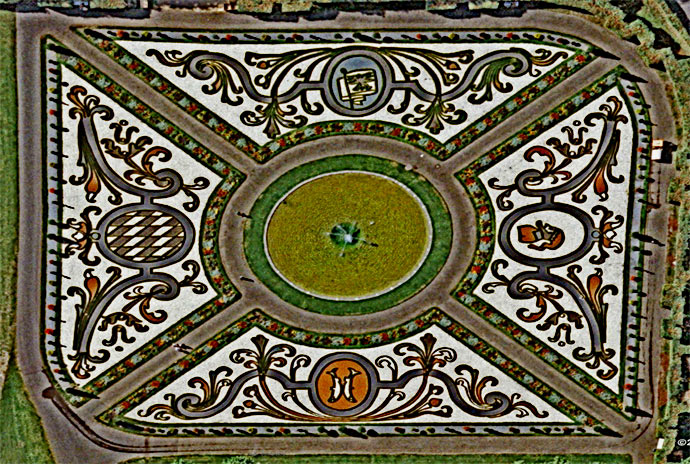
The gardens at Ludwigsburg am Neckar, near Stuttgart, Germany, were laid out in the French parterre style beginning in the early eighteenth century. In the years since, they have been repeatedly dug up and replanted, according to the latest trends in grand gardening, and they have occasionally been allowed to lapse toward wilderness. The most recent renovation--a tiny corner of which is shown here--restores the gardens to their appearance circa 1800.
A duke named Ludwig started the gardens because the front yard of his hunting lodge looked barren and boring. The lodge also went through cycles of renovation and disrepair, eventually becoming one of Germany's largest baroque palaces.
Ludwigsburg
Germany
garden
aerial view
(Image credit: Based on aerial photo by AeroWest)
Oct 30, 2010
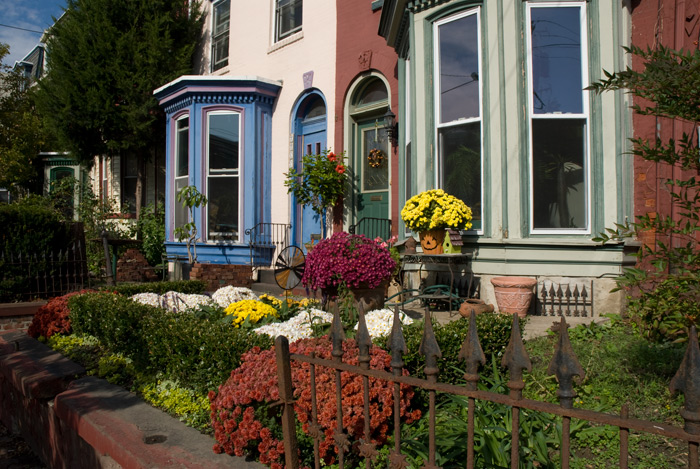
This front garden is on Bainbridge Street in Philadelphia, around the corner and down the block from where we're living. Do you think these people have a backyard, too?
garden
fall
Jun 27, 2011
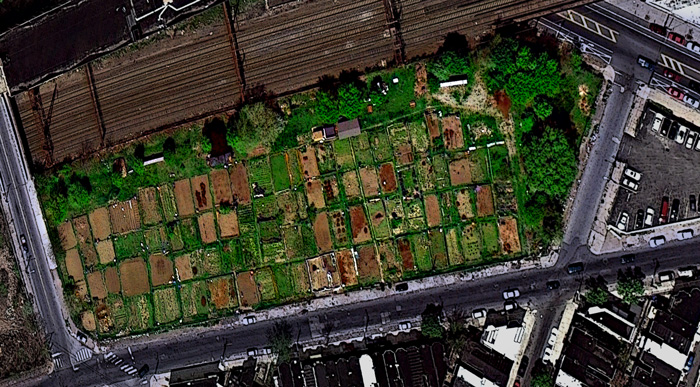 Glenwood Green Acres sits hard by the railroad tracks in north Philadelphia, on a strip of land where abandoned warehouses burned down in 1984. Ninety-six families in the neighborhood till plots in this community garden; some of them work at it full time, selling their produce or giving it to the hungry.
Glenwood Green Acres sits hard by the railroad tracks in north Philadelphia, on a strip of land where abandoned warehouses burned down in 1984. Ninety-six families in the neighborhood till plots in this community garden; some of them work at it full time, selling their produce or giving it to the hungry.
Their crops include: collard greens, peppers, eggplant, squash, string beans, okra, blackberries, cotton, and tobacco. The southern character of what is grown reflects the southern roots of many people in the north Philly neighborhoods surrounding Glenwood. People like to grow what they grew up growing.
Room to garden in is hard to come by in most of Philadelphia, where row houses line the streets with little or no yard space. There are community gardens all over town–an estimated 400 active ones–but most are tiny, typically occupying just a few hundred square feet in a vacant lot that the gardeners don't own and can't protect from development.
Glenwood is huge by comparison: 3.5 acres. And it's owned by a citywide land trust and operated by a neighborhood organization. The garden is deeded as public green space forever.
The number of vacant lots in the city is thought to be well over 30,000, and most of them are derelict. But after twenty years of struggling to purchase and protect land for Philadelphia's community gardens, the trust now owns just 22 parcels totaling less than 10 acres.
Meanwhile, for what it's worth, in my little one-pot garden, I have a golf-ball-sized tomato, plus 4 flowers on the plant and more buds than I can count. I'm so optimistic I'm not fit to be around.
landscape
cityscape
garden
birdseye view
Philadelphia
Glenwood Green Acres
railroad tracks
Jan 31, 2012
 In a garden of sculpture, mosaics, and murals in North Philadelphia, this memorial commemorates the 64 graduates of nearby Edison High School who were killed in Vietnam. According to the writing on the memorial wall, no other public school in America sent more students to die in that war than did Edison.
In a garden of sculpture, mosaics, and murals in North Philadelphia, this memorial commemorates the 64 graduates of nearby Edison High School who were killed in Vietnam. According to the writing on the memorial wall, no other public school in America sent more students to die in that war than did Edison.
garden
mural
public art
North Philly
memorial
Apr 9, 2012
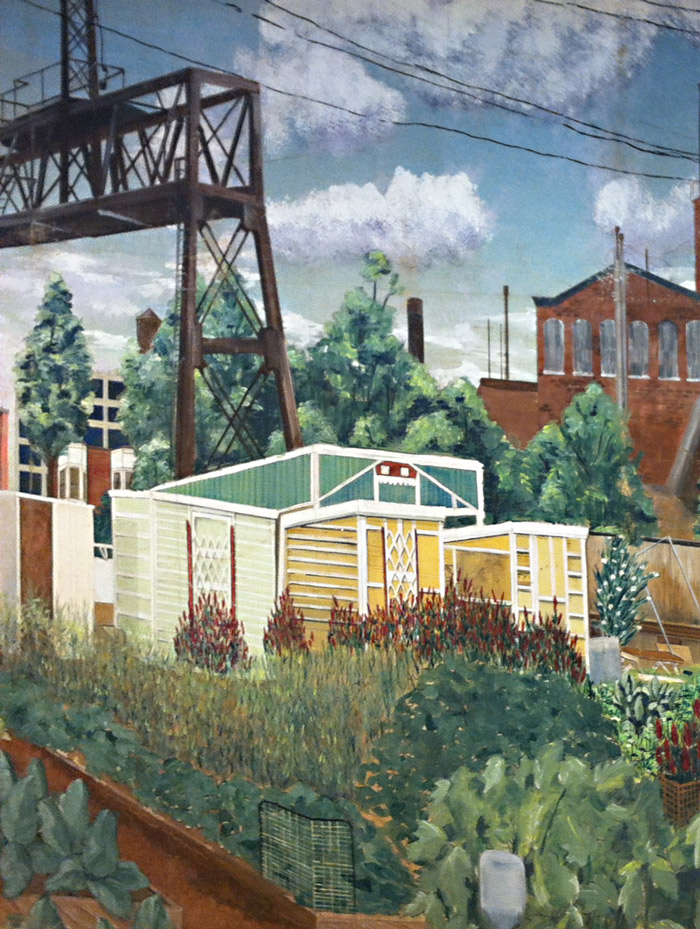 Detail from a painting in the offices of the Pennsylvania Horticulture Society; artist and title unknown (to me).
Detail from a painting in the offices of the Pennsylvania Horticulture Society; artist and title unknown (to me).
painting
landscape
cityscape
garden
Philadelphia
farm
Jun 23, 2012
 This picture needs something to suggest the scale of what we're looking at in the University of Alaska botanical garden in Fairbanks. The person in the background isn't really close enough to the cabbage that's the center of attention here. But perhaps, if you know about those Alaska cabbages that top out at 50 or 100 pounds or suchlike, inspired by sunshine 24 hours a day, then you can freely imagine the scale and be appropriately impressed. (Hint: Think Little Shop of Horrors.)
This picture needs something to suggest the scale of what we're looking at in the University of Alaska botanical garden in Fairbanks. The person in the background isn't really close enough to the cabbage that's the center of attention here. But perhaps, if you know about those Alaska cabbages that top out at 50 or 100 pounds or suchlike, inspired by sunshine 24 hours a day, then you can freely imagine the scale and be appropriately impressed. (Hint: Think Little Shop of Horrors.)
landscape
garden
summer
Alaska
Fairbanks
Jun 28, 2012
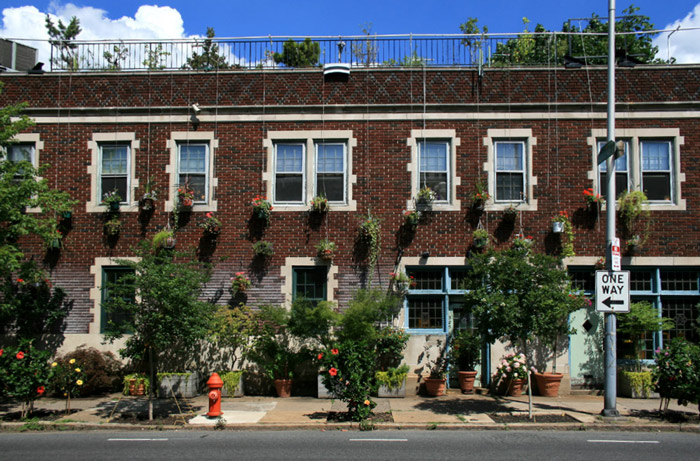 In hot weather, watering all this must be a serious chore. The greenery actually wraps around the corner from 22nd Street, shown here, onto Pine Street. Some of it is edible; all of it is awesome.
In hot weather, watering all this must be a serious chore. The greenery actually wraps around the corner from 22nd Street, shown here, onto Pine Street. Some of it is edible; all of it is awesome.
garden
streetscape
flowers
Philadelphia
neighborhood
building
Fitler Square
22nd Street
(Image credit: Steve Ives)
Dec 6, 2012
 Fish swim amongst rippling reflections in Yves Saint-Laurent's Moroccan oasis, the Majorelle Gardens in Marrakesh.
Fish swim amongst rippling reflections in Yves Saint-Laurent's Moroccan oasis, the Majorelle Gardens in Marrakesh.
French painter Jacques Majorelle designed the gardens in 1924 as a botanical conservatory for desert plants and a celebration of Moroccan style and color. But ever since the 1950s, when Majorelle suffered serious injuries in a car accident and returned to France, the gardens languished unattended. Saint-Laurent, who had a vacation home in Marrakesh, bought the place in 1980 and worked for years to restore it. Per his directive, his ashes were scattered here following his death in 2008.
fish
garden
pond
Yves Saint-Laurent
pool
Morocco
Jaques Majorelle
Marrakesh
(Image credit: K. Maldre)
Jan 18, 2013
 A camera hanging from a kite flew over the neighborhood a couple of weeks ago and snapped this view of the community garden in Schuylkill River Park.
A camera hanging from a kite flew over the neighborhood a couple of weeks ago and snapped this view of the community garden in Schuylkill River Park.
The garden, which contains 70 plots that rotate every six years to area gardeners on a lengthy waiting list, was started about thirty years ago in an abandoned brickyard at a railroad siding. In the early years, plants were watered from 55-gallon drums filled at a nearby fire hydrant.
Since 2009, gardeners have participated in Philadelphia's City Harvest Program, which provides produce to city food cupboards. The seedlings set out into the garden for City Harvest were started from seed by inmates in Philadelphia prisons. Through this program, the annual contribution to food cupboards from Schuylkill River Park is about 500 pounds of fruit and vegetables.
Looks like this year's winter weather hasn't been much of a challenge to the plantings here, at least not yet.
garden
Schuylkill River Park
kite
Philly
community garden
Mar 5, 2013
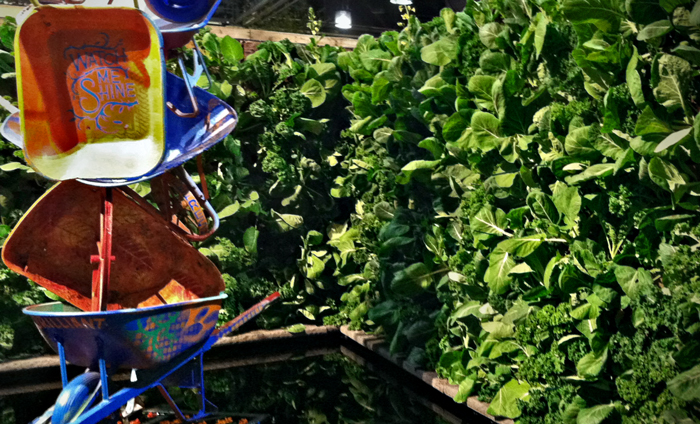 If this is the first week of March in Philadelphia, then it must be time for the Flower Show. Here in the Urban Gardens exhibition, we see a green wall of collards and kale, growing in dirt packed into a latticework on the wall.
If this is the first week of March in Philadelphia, then it must be time for the Flower Show. Here in the Urban Gardens exhibition, we see a green wall of collards and kale, growing in dirt packed into a latticework on the wall.
Both kale and collards are tough enough to last well into the wintertime in Pennsylvania, so something like this could theoretically eke a little green wonderfulness out of a tiny little yard like mine during the season after the tomatoes are all tuckered out. I'm sure that a green wall is way too demanding, both green-thumb-wise and carpentry-wise, for a wishful sort of lazy gardener like me, but I can already taste that pot liquor.
Meanwhile, needless to say, they're finally predicting a little snow for our city.
garden
winter
Philadelphia
flower show
vegetables
Jul 7, 2013
 In my humble opinion, in my humble backyard, even the hibiscus is not completely happy with life when the mercury hits 94 and the heat index is over 100.
In my humble opinion, in my humble backyard, even the hibiscus is not completely happy with life when the mercury hits 94 and the heat index is over 100.
You'd think something tropical and well-watered that only had to hold it together for a single day could bloom right through the scorching. And you'd be almost right. These flowers are still beyond awesome, at least a 20 on a scale of 1 to 10. But the heat's in charge these days, not the petals.
Air conditioning is my friend.
garden
summer
Philadelphia
flower
Kater Street
Sep 26, 2013
 We're told the egg may hatch soon. Watch this space for updates.
We're told the egg may hatch soon. Watch this space for updates.
Alabama
garden
bird
yardscape
sticks
Mobile
nest
(Image credit: Little Fuji)
Oct 27, 2013

Icelandic sculptor Steinunn Thorarinsdottir populated this garden just south of the Art Institute with aluminum and cast iron people.

garden
Chicago
sculpture
trompe l'oeil
Norman
park
iphone
Segways
iPad
(Image credits: Little Fuji)
Nov 10, 2013
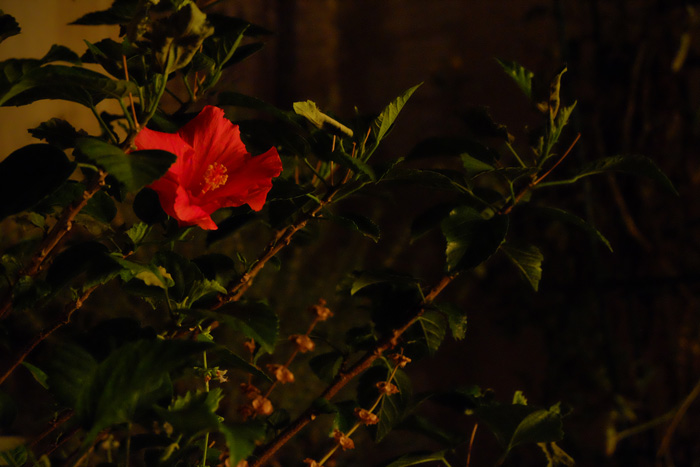 We shot this picture at night because well-mannered hibiscus flowers fold up and die at night, after just a single day of wide-open gorgeousness. This bloom's behavior is out of line; it has glowed like this for four or five days and nights now, and it shows no sign of giving up.
We shot this picture at night because well-mannered hibiscus flowers fold up and die at night, after just a single day of wide-open gorgeousness. This bloom's behavior is out of line; it has glowed like this for four or five days and nights now, and it shows no sign of giving up.
We should note that it's cold outside, downright frosty at night. And well-mannered hibiscus plants don't bloom at all in November in Pennsylvania. They give up and die.
There are no more buds on this plant, and many of the leaves have dropped now, or curled up, or turned brown and crunchy. So when this flower goes, that's it; the show's over. But what a show.
In richness and boldness of color as well as in longevity, this last swan song of a flower really outdid the pale, delicate blooms of summer. But oddly, perhaps, if we carefully compare the hibiscus flower of November with a flower from the same plant back in July, it becomes apparent that this new all-night, all-weather blossom is missing its male parts. And that's all there is to say about that.
garden
night
flowers
hibiscus
cold
(Image credit: Little Fuji)
May 28, 2014
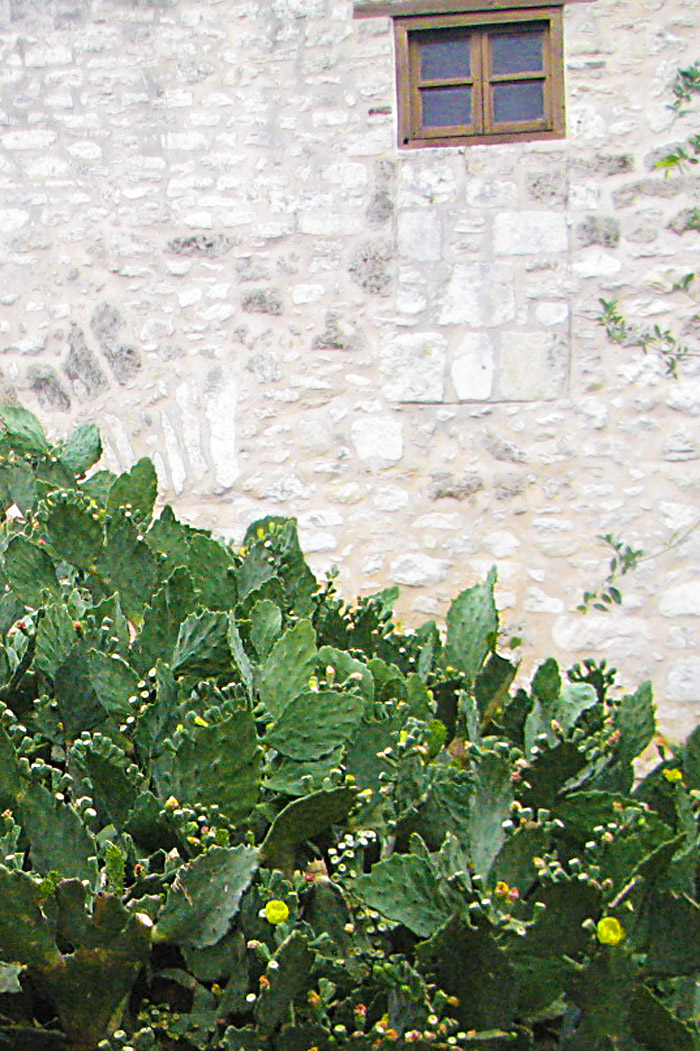 It's springtime, and the cactus flowers are seriously blooming in San Antonio, but don't even think about trying to sneak into the Alamo by climbing through the little window visible here.
It's springtime, and the cactus flowers are seriously blooming in San Antonio, but don't even think about trying to sneak into the Alamo by climbing through the little window visible here.
Texas
garden
streetscape
flowers
San Antonio
Alamo
(Image credit: Carolyn Duffy)
Jul 22, 2014
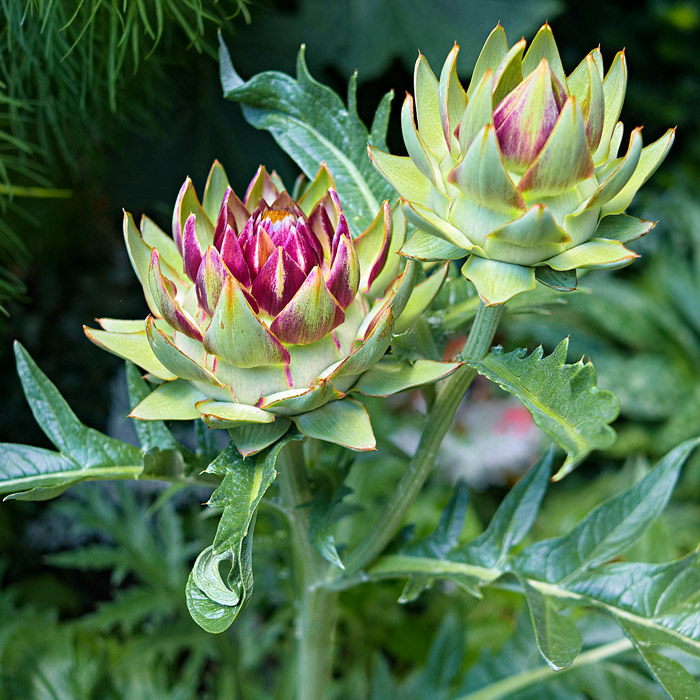 In back of the parking garage at 1700 South Street is a block-long garden on Kater Street, where nobody picked the artichokes in the edible-bud stage. They're flowers now.
In back of the parking garage at 1700 South Street is a block-long garden on Kater Street, where nobody picked the artichokes in the edible-bud stage. They're flowers now.
garden
summer
flowers
Kater Street
artichoke
(Image credit: Fuji T)
Nov 11, 2014
 'Tis not the season yet for Philly's New Years Day Mummery on parade, but mums of spectacular colors and colorful spectacle are already among us, at the Longwood Gardens Chrysanthemum Festival.
'Tis not the season yet for Philly's New Years Day Mummery on parade, but mums of spectacular colors and colorful spectacle are already among us, at the Longwood Gardens Chrysanthemum Festival.
Above, the Longwood horticulturists grafted more than a hundred varieties of mums onto a single stem and somehow got them all blooming at the same time.
Below is a single bloom of the 'Nijin Bigo' cultivar, which we are told translates as 'Irregular incurve' Chrysanthemum morifolium.
And below that is the festival scene, in Longwood's main conservatory in Kennett Square, Pennsylvania.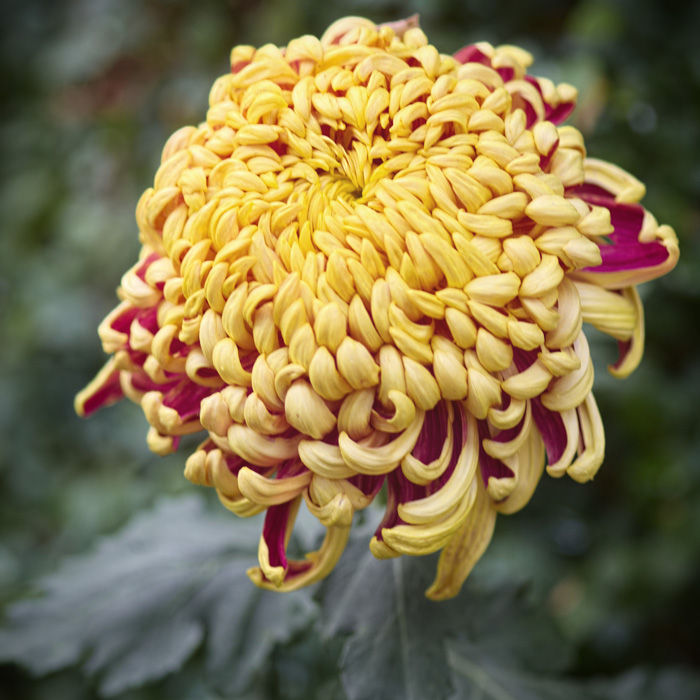
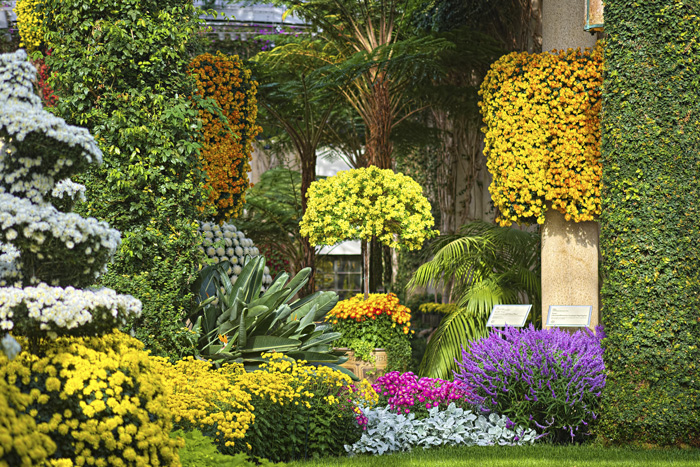
garden
flowers
Longwood Gardens
Kennett Square
chrysanthemums
(Image credit: Fuji T)
Nov 18, 2014
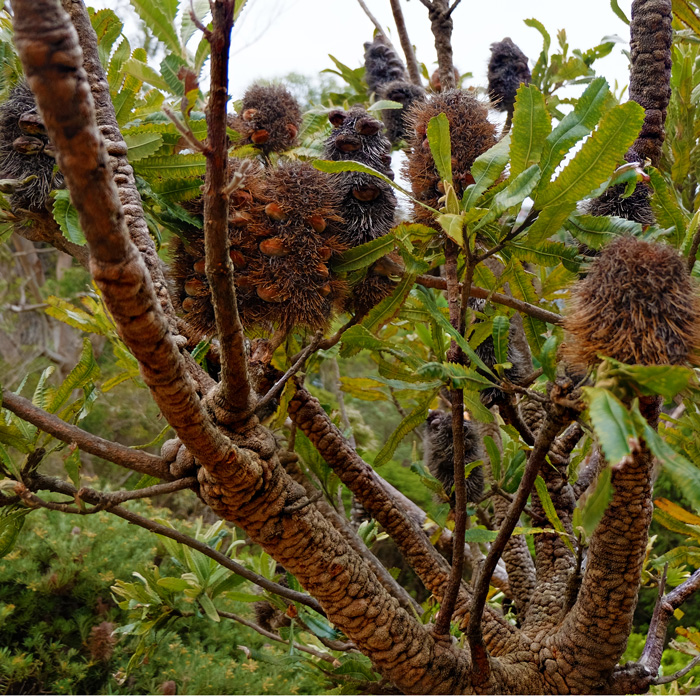 The gnarled little trees called wallum banksia thrive in the sandy heathlands along Australia's east coast, from Queensland down into northern New South Wales around Sydney. Tall spikes of yellow-green flowers linger for months on the branches, drying out and turning brown and then gray; the knobby fruits–seed follicles–may hang on the plant indefinitely, at least until a brush fire sweeps across the countryside, which is something that happens there about every seven to twelve years.
The gnarled little trees called wallum banksia thrive in the sandy heathlands along Australia's east coast, from Queensland down into northern New South Wales around Sydney. Tall spikes of yellow-green flowers linger for months on the branches, drying out and turning brown and then gray; the knobby fruits–seed follicles–may hang on the plant indefinitely, at least until a brush fire sweeps across the countryside, which is something that happens there about every seven to twelve years.
Wallum banksia are not harmed by fire, nor by salt spray or nutrient-starved sandy soil or extended drought. The species has evolved to thrive in extremely harsh conditions, in a habitat which, like the species itself, is known as wallum.
Fire may burn up the leaves and branches, but it also pops open the seed follicles, allowing new little wallum banksia to sprout up all around the old ones. Also, the roots often push up new growth after a fire, helping the species reclaim the territory from other opportunistic seeds that might be trying to spread thereabouts.
The specimen pictured here is not in Australia at all, but in the Australian garden area of Wellington Botanic Gardens in New Zealand. The climate in almost all of New Zealand is cooler and far moister than in most parts of Australia, and wallum banksia does not grow naturally in New Zealand. In fact, it is said that the healthiest, largest, fastest-growing specimens are in dry, sunny, fire-prone locations with poor soil comprised mostly of sand.
garden
tree
fruit
seeds
Wallum Banksia
Australian flora
Wellington Botanic Gardens
(Image credit: Little Fuji)
Apr 11, 2015
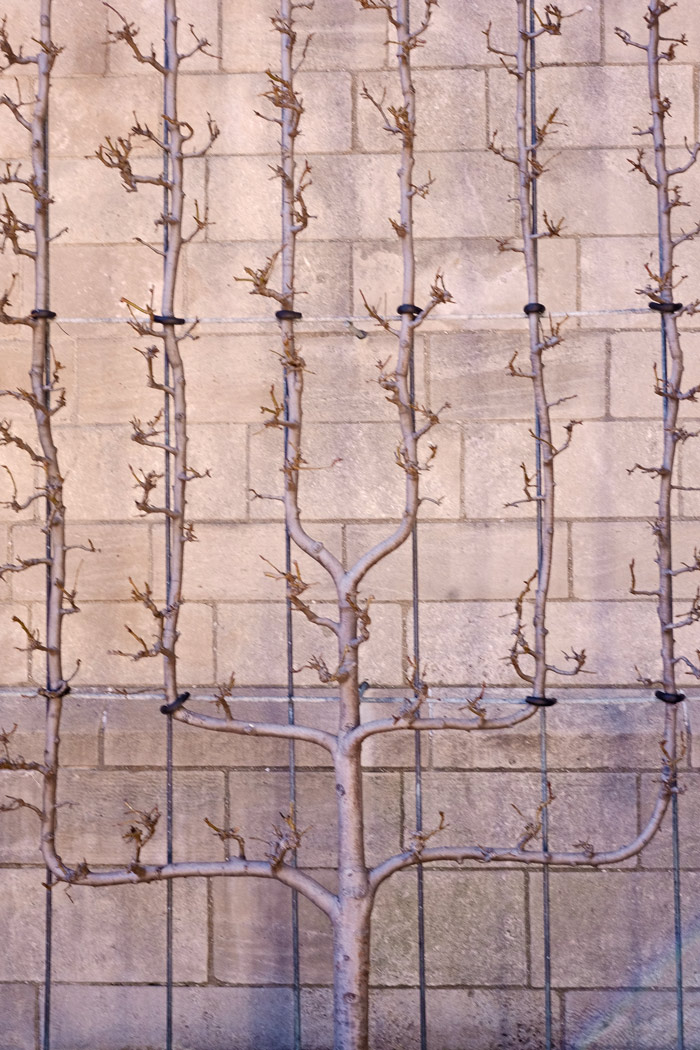 One week ago, on a chilly but sunny New York afternoon, this espaliered pear tree in the Cloisters medieval garden was trying really, really hard to leaf out.
One week ago, on a chilly but sunny New York afternoon, this espaliered pear tree in the Cloisters medieval garden was trying really, really hard to leaf out.
Manhattan
garden
tree
spring
New York City
medieval
wall
Cloisters
(Image credit: Fuji T)
Feb 12, 2016
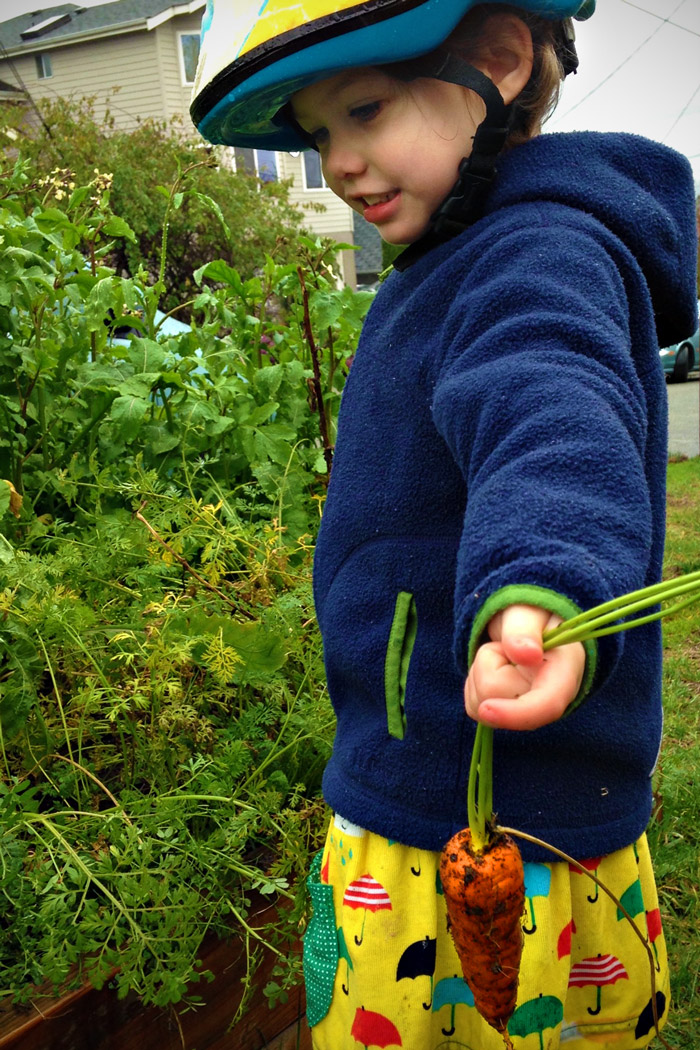 When Dia got off the bike yesterday, she found something orange and dirty but tasty-looking in the garden. February in Seattle must not be quite as hard on green stuff as February back east.
When Dia got off the bike yesterday, she found something orange and dirty but tasty-looking in the garden. February in Seattle must not be quite as hard on green stuff as February back east.
garden
Seattle
child
Dia
carrot
(Image credit: Tricia)
Mar 12, 2016
 Mandrake, a plant of biblical, medieval, literary, medical, and comic book significance, blooms in April in New York City, in the garden of the Cloisters at the northern tip of Manhattan.
Mandrake, a plant of biblical, medieval, literary, medical, and comic book significance, blooms in April in New York City, in the garden of the Cloisters at the northern tip of Manhattan.
Mandrake flowers, shown here as buds just beginning to open, are pretty little bell-shaped blossoms, but they are traditionally of little interest. The leaves are heavy and heart-shaped and can grow huge over the course of a summer, but they too are mostly overlooked. With mandrake, a plant native to the Mediterranean region, it's all about the root.
Mandrake root is long and thick and often split into two legs, sometimes arguably resembling the human form. It's also powerfully sleep-inducing when ground and soaked; it was used as an anesthetic in antiquity and into the Middle Ages. In the bible, and perhaps also in the poetry of John Donne, extract of mandrake root cured infertility. In folklore all over Europe, a human-shaped mandrake root in your pocket offered protection even if the church was not on your side; Joan of Arc was charged with "habitually" carrying root of mandrake.
Mandrake was said to spring up in ground drenched with blood or semen from a man being hanged. If you pulled the plant up out of the ground, as Shakespeare warned us, its man-root would scream, and you could die from hearing the scream. There was a report as late as the ninteenth century of a British gardener falling down the stairs and dying after accidentally pulling up a volunteer mandrake.
(In Harry Potter, of course, young witches and wizards wore protection.)
In 1934, "Mandrake the Magician" emerged as the world's first modern costumed superhero, in a newpaper comic strip that ran continuously until 2013. The hero Mandrake's ability to instantly hypnotize bad guys may have been, pardon the expression, rooted in the medicinal tradition of the mandrake plant.

Manhattan
garden
flowers
New York City
plants
Harry Potter
mythology
The Cloisters
mandrake
Ron Weasley
Mar 27, 2016
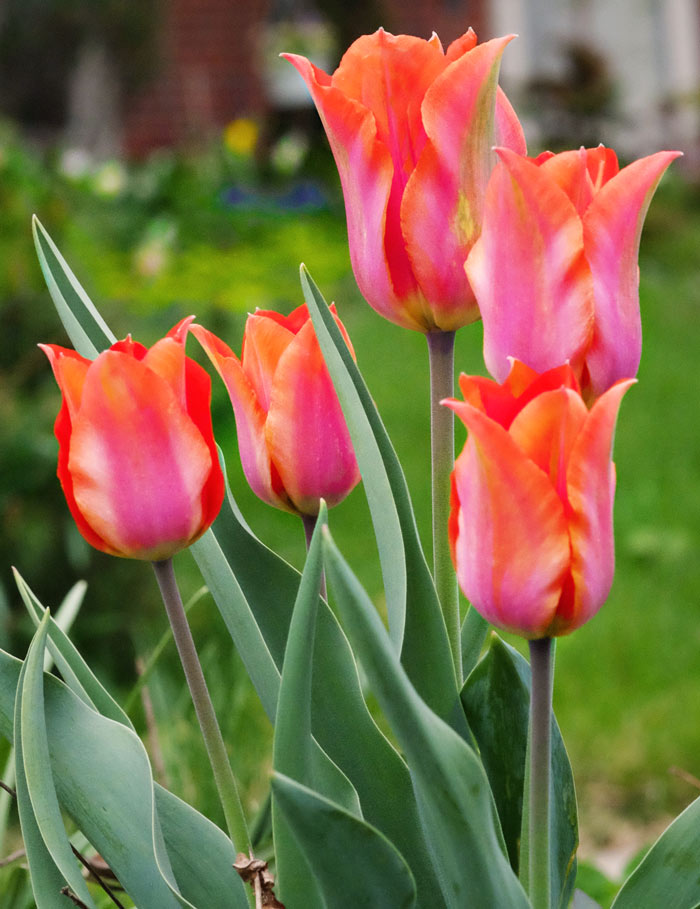 The tulips aren't here yet, but May is close now, just a wing and a prayer and a hop and a skip and a whiff and a shrug away.
The tulips aren't here yet, but May is close now, just a wing and a prayer and a hop and a skip and a whiff and a shrug away.
garden
Michigan
flowers
spring
tulips
May
May 2014
(Image credit: Little Fuji; h/t Edie Kieffer)
Apr 7, 2016
 Inside the screened porch in Columbia, Missouri, are tulips, safe from the deer. Outside in the yard is a homemade wood-fired bread oven.
Inside the screened porch in Columbia, Missouri, are tulips, safe from the deer. Outside in the yard is a homemade wood-fired bread oven.
garden
flowers
springtime
porch
Columbia
Missouri
oven
(Image credit: Mary Jo Neitz)
Jan 27, 2017

Laura Ingalls Wilder, who was said to be a tiny woman, less than five feet tall, tends her vegetable garden at Rocky Ridge farm in the southern Missouri Ozarks.
The photo is probably from the late 1920s or early 1930s, when Laura was in her sixties and working on her "Little House" series of books about her childhood in cabins and shanties and covered wagons on the midwestern frontier.
Her daughter Rose Wilder Lane–who referred to her as Mama Bess–conceived the literary project and worked for years behind the scenes to prepare Laura's stories for publication. Rose was a widely known writer at the time who kept her role in the "Little House" books a secret.
By the time mother and daughter were working on Laura's stories, they were not getting along well, and Rose was developing an obsession with extreme libertarian politics. They quarreled over what to put in and what to leave out and what to emphasize and how to describe things; it seems that Laura usually but by no means always had the last word.
In the middle of the work, which took more than ten years, Rose picked up and moved to Connecticut; they completed the collaboration by mail and long distance phone calls. They rarely saw each other again.
Rose's political extremism eventually ruined the writing she did in her own name; she became a ridiculous crank. Even a book she wrote for Woman's Day about needlework became an anti-communist screed. But while she was able to sneak some of her libertarian ideology into the Little House stories, Laura's no-nonsense approach apparently kept the focus on the adventures of Ma and Pa and the girls and Jack the brindle bulldog.
Rose's political writing celebrated the subsistence farmer as the only real American, free and self-reliant. She interpreted her mother's pioneering background as the classic American experience, even though the family's wanderings on the frontier had quickly forced them out of subsistence farming and eventually out of farming altogether.
To Rose, the hardships of pioneering were ennobling challenges. To Laura, they had been hardships, suffering, tough times in life. To several generations now of American children, they were awesome adventures.
garden
Laura Ingalls Wilder
1920s–1930s
vegetable garden
pioneer
Little House books
(Image credit: Laura Ingalls Wilder Historic Home & Museum)
Mar 12, 2017

John must have been about eight years old when he came across the special offer in a seed catalog: hey kids, add a penny of your own money to your parents' seed order, and you'll get a super fantastic packet of seeds just for you to plant.
If I remember correctly, we taped the penny to the order form, and I got my seeds and he got his. Both our gardens did pretty well that summer, thanks to the good advice of our neighbor on Fifth Avenue in Tuscaloosa, Mr. Crawford. John's turnip, shown here, must have been exactly the super fantastic return he'd been hoping for on his investment–and yup, he's still a gardener today, thirty years later.
At harvest time, he posed for a Polaroid snapshot in the kitchen with his brothers, Joe and Ted. Joe appears to be checking out a previously shot Polaroid, probably watching the colors emerge magically from the paper. Ted appears to be annoyed. Jealous maybe, of his brother's turnip?
Tuscaloosa
garden
John
Joe
Ted
Fifth Avenue
seeds
turnip
1986
Mar 23, 2017
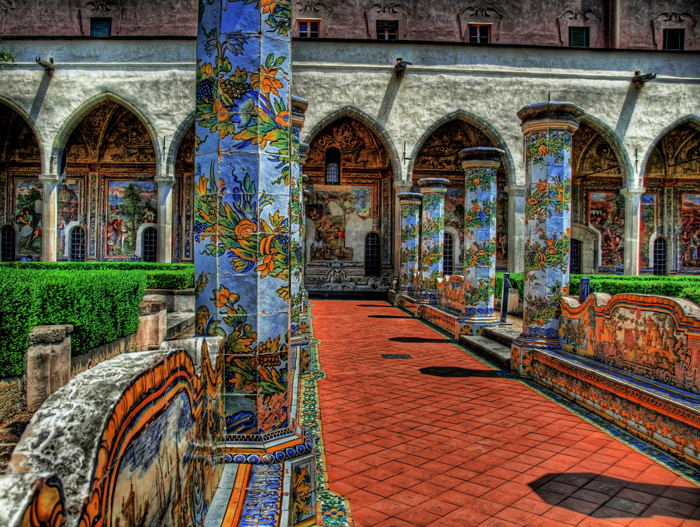 In the year 1212, the woman who became Saint Clare of Assisi founded the Poor Clares order of nuns. From the beginning, Poor Clares sisters were entirely cloistered and took vows of poverty much more extreme than those of other nuns of the time; they owned no property whatsoever, individually or collectively, and depended on alms for survival.
In the year 1212, the woman who became Saint Clare of Assisi founded the Poor Clares order of nuns. From the beginning, Poor Clares sisters were entirely cloistered and took vows of poverty much more extreme than those of other nuns of the time; they owned no property whatsoever, individually or collectively, and depended on alms for survival.
For the past 700 years, Poor Clares in Naples, Italy, have lived here, in Santa Chiara, a church and monstery complex built for them by Queen Sancha of Majorca and King Robert of Naples. The complex was extensively remodeled in the eighteenth century, with the addition of exuberant ornamentation, especially in this garden, that seems difficult to square with the nuns' professed poverty and simple life apart from the world.
Indeed, the tiled benches illustrate decidedly non-religious scenes, from masked pageantry at Carnival to peasants chasing after pigs. The tiles on the columns are garlanded in flowers and fruit: lemon trees, grape vines, figs and bananas. The designer was Domenico Antonio Vaccaro, an architect and sculptor known for imposing a personal stamp on every project, no matter what the client might have had in mind.
For two more centuries, the Poor Clares stayed on in Vaccaro's fanciful cloister, until 1995, some years after they had downsized to a smaller monastery next door. For the first time, their garden was opened to visitors from outside the order.
garden
Italy
Naples
tiles
Domenico Antonio Vaccaro
Majolica tiles
Poor Clares
Rococo
Santa Chiara
King Robert of Naples
cloister
Queen Sancha of Majorca
(Image credit: Trey Ratcliff via StuckInCustoms)
Apr 25, 2017
 Pausing for her picture in 1939, on her way back to the house from the pepper patch. The pincurls in her hair suggest that she's got post-pepper-picking plans for the evening.
Pausing for her picture in 1939, on her way back to the house from the pepper patch. The pincurls in her hair suggest that she's got post-pepper-picking plans for the evening.
She was one of eight children in the Schrock family in the Yakima Valley of Washington state, where they were clients of a Farm Security Administration tenant-purchase program, a New Deal effort to help migrant farm families obtain homes and farmland of their own. The program worked best, it turned out, for families that broke the rules and generated some cash income by finding work off the farm.
Johnny Cash grew up in a similar FSA project in Dyess, Arkansas.
garden
Farm Security Administration
Depression
child
Schrock family
1939
girl
Yakima Valley, Washington
(Image credit: Dorothea Lange via Shorpy)
Mar 30, 2018

garden
Taiwan
streetscape
(Image credit: J Gilliam)





 This picture needs something to suggest the scale of what we're looking at in the University of Alaska botanical garden in Fairbanks. The person in the background isn't really close enough to the cabbage that's the center of attention here. But perhaps, if you know about those Alaska cabbages that top out at 50 or 100 pounds or suchlike, inspired by sunshine 24 hours a day, then you can freely imagine the scale and be appropriately impressed. (Hint: Think Little Shop of Horrors.)
This picture needs something to suggest the scale of what we're looking at in the University of Alaska botanical garden in Fairbanks. The person in the background isn't really close enough to the cabbage that's the center of attention here. But perhaps, if you know about those Alaska cabbages that top out at 50 or 100 pounds or suchlike, inspired by sunshine 24 hours a day, then you can freely imagine the scale and be appropriately impressed. (Hint: Think Little Shop of Horrors.)
























